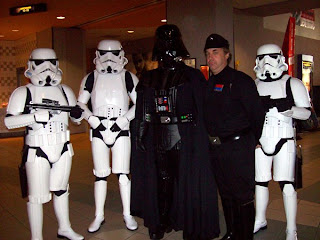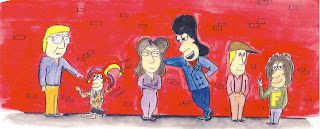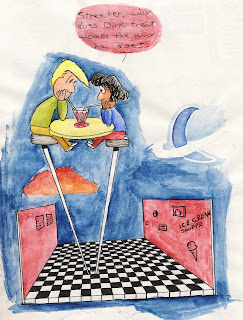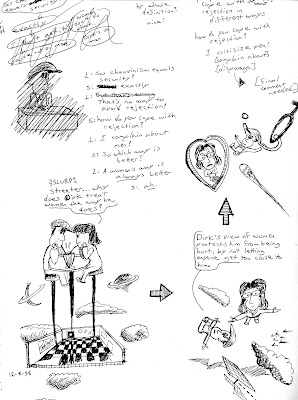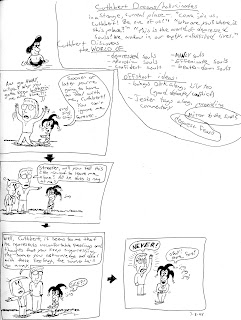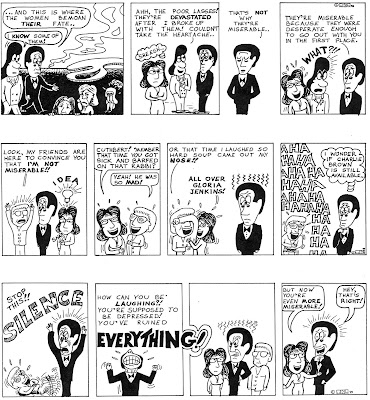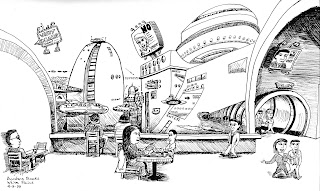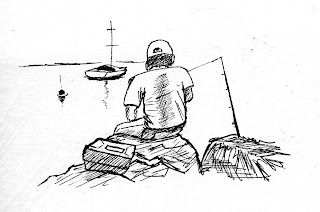It's time again for some more interesting art and cartooning-related links to explore. We'll start off today with a look at some more examples of illustration and comics that are worth noting. Art is not created in a vacuum; it requires exposure to other artists, techniques and concepts. Enjoy these examples and links! Everybody knows that Dr. Seuss (otherwise known as Theodore Geisel) wrote children's books. Less known is his work in commercial art, creating illustrations for a variety of products. He was also a prolific editorial cartoonist during World War 2, and created many illustrations opposing Adolph Hitler and the dictator Benito Mussolini. You can learn more about Dr. Seuss here. Below are some examples of Geisel's work in commercial art, from the website The Advertising Artwork Of Dr. Seuss. Be sure to check it out!
Everybody knows that Dr. Seuss (otherwise known as Theodore Geisel) wrote children's books. Less known is his work in commercial art, creating illustrations for a variety of products. He was also a prolific editorial cartoonist during World War 2, and created many illustrations opposing Adolph Hitler and the dictator Benito Mussolini. You can learn more about Dr. Seuss here. Below are some examples of Geisel's work in commercial art, from the website The Advertising Artwork Of Dr. Seuss. Be sure to check it out!



Geisel did most of his commercial art for an insect spray called Flit, and created a large number of amusing illustrations for this product.
 What's next for the genre of comic strips? Will the decline in newspaper readership be the end of the traditional comic strip format?
What's next for the genre of comic strips? Will the decline in newspaper readership be the end of the traditional comic strip format?
An article in the New York Times (The Comics Are Feeling The Pain Of Print, New York Times, 12/26/08 by Leslie Berlin) describes a trend of comic illustrators to make their strips available across a wider range of formats instead of strictly in the newspaper. With fewer people reading actual, paper newspapers, and the Internet being the primary source of information, syndicates that market comic strips, and artists themselves, are trying to find a way to stay relevant. In the late 1800s and early 1900s, newspapers flourished, and there were several editions a day. You could pick up the morning paper, the afternoon paper, or the evening paper. Men like William Randolph Hearst (the inspiration for the movie Citizen Kane) and Joseph Pulitzer became millionaires running newspaper empires. It was the rivalry between Hearst and Pulitzer that led to the first comic strip with regular characters, The Little Bears, drawn by James Swinnerton (shown above). The strip was designed to do one thing: sell more newspapers. The comic strip was enormously popular and propelled Swinnerton to the top of his career (you can read more about James Swinnerton HERE).
In the late 1800s and early 1900s, newspapers flourished, and there were several editions a day. You could pick up the morning paper, the afternoon paper, or the evening paper. Men like William Randolph Hearst (the inspiration for the movie Citizen Kane) and Joseph Pulitzer became millionaires running newspaper empires. It was the rivalry between Hearst and Pulitzer that led to the first comic strip with regular characters, The Little Bears, drawn by James Swinnerton (shown above). The strip was designed to do one thing: sell more newspapers. The comic strip was enormously popular and propelled Swinnerton to the top of his career (you can read more about James Swinnerton HERE).
Comic strips in newspapers flourished, with some taking up whole pages. Beautifully rendered strips like Prince Valiant (right), and satirical, whimsical strips like The Katzenjammer Kids (below left) became household staples. It was the golden age of the American comic strip, and the American newspaper.
With newspapers in decline these days, the comic strip page is a shadow of its former self, with some papers devoting only a third of one page to comic strips. New artists have a hard time breaking into the industry, with dwindling numbers of papers supporting artists. Increasingly, more comic strip artists are taking their creations on-line, as well as in print; many strips can be found on-line only. In order to survive, artists are having to make their comic strips available not only in print, but on websites, and mobile devices. An era of American art is beginning to come to an end.
One syndicate, United Features Syndicate, distributor of many strips including Peanuts, Dilbert and others, is choosing to put all their comic strips on-line for free, at comics.com. After initially charging users to view comics, they decided that this was limiting the comic strips' exposure too much. The fee was dropped, and visits to the site soared. Do yourself a favor and visit the site, and acquaint yourself with some of the different styles of the comic strip artists on the site.
What's next for comics, as the newspapers begin to move on-line from the printed page? Only time will tell.
Graphic novels are a relatively new literary phenomenon, and the term is used loosely to describe a type of comic that usually has a beginning, middle and an end, and deals with more diverse and mature themes than the children's or superhero comic books do. One of the advantages of the genre is its diversity; graphic novels can take almost any form, using almost any drawing mediums, and can be about almost anything. Anyone can do a graphic novel, about anything, which is the allure of this format. Graphic novels are simply another way to tell a story, and they can be three pages long, or three hundred. To give you a glimpse of the diversity of this format, I've showcased some examples. Click on each example to get a larger view, to appreciate the technique used to create them. "Percy Gloom" by Cathy Malkasian
"Percy Gloom" by Cathy Malkasian
This graphic novel is done entirely in two shades of colored pencil, giving it a dreamy, fantasy-world like appearance. It is about a shy, insecure little man named Percy Gloom who runs into a series of very odd people during his attempts to get a job at a company that writes warning labels. The plot , which drifts almost aimlessly, is secondary to the artwork however. One needn't have a huge arsenal of pens, brushes, inks and paints to create a graphic novel; in Ms. Malkasian's case, she only needed paper and two colored pencils.
"Carnet De Voyage" by Craig Thompson

Less a graphic novel than an illustrated travel diary, Thompson created this when traveling through France, Barcelona and Switzerland while researching his next graphic novel, Habibi. It is an entertaining read, filled with sketches of people Thompson had met and places he visited, along with diary entries. It is interesting to read his descriptions of the people he meets, along with the loneliness and frustration he sometimes feels. The lesson from this example is don't think you have to go into a project knowing exactly what is going to happen. Make it up as you go along!
 Storyboards, as you may already know, are very rough sketches that are done in the pre-production phase of a movie, to plan exactly how a particular sequence or scene in a movie will be shot. That way, no time is wasted when the cameras are ready to roll; everybody knows exactly what will happen ahead of time, saving time and money. Some filmmakers storyboard the entire movie when they are working with a small budget, in order to be as efficient as possible.
Storyboards, as you may already know, are very rough sketches that are done in the pre-production phase of a movie, to plan exactly how a particular sequence or scene in a movie will be shot. That way, no time is wasted when the cameras are ready to roll; everybody knows exactly what will happen ahead of time, saving time and money. Some filmmakers storyboard the entire movie when they are working with a small budget, in order to be as efficient as possible. Storyboard sketches are rough and quick, not intended to be artistic; they are intended only to convey important information when planning a movie's filming schedule. However, they are an art form in their own right, and offer glimpses of early ideas being considered before filming begins.
Storyboard sketches are rough and quick, not intended to be artistic; they are intended only to convey important information when planning a movie's filming schedule. However, they are an art form in their own right, and offer glimpses of early ideas being considered before filming begins.This Flickr set of early Star Wars storyboard sketches are fascinating; a "pirate ship" which would later be the Millinium Falcon (and looks nothing like the Falcon that we know today), and early sketches of Darth Vader in his TIE fighter.

Storyboards have a long history, originating from the Disney studios in the 1930s. You can read more about storyboards here.






























